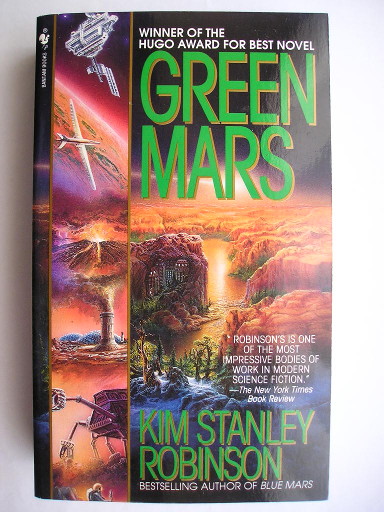
The novel “Green Mars” by Kim Stanley Robinson was published for the first time in 1994. It won the Hugo and Locus Awards. It’s the second novel in the Mars trilogy and follows “Red Mars“.
In the decades after the 2061 revolution on Mars terraforming operations continue and more and more colonists arrive. The ideas about the future of the planet keep on being different among the surviving First Hundred and even more so with Earth’s interests aimed at the exploitation of local resources.
New generations of real Martians are raised, some of them in hiding like Nirgal’s belongs, which becomes increasingly important. Gradually Mars changes as tensions among various factions increase: the result will determine the future of the planet, which is not so red anymore.
“Green Mars” picks up the story of Mars colonization and especially the changes taking place on the planet. At the end of the 21st century, the human population consists of several million between colonists arrived from Earth and the new generations born on the planet. The terraforming operations are thickening the atmosphere and allowing the growth of plants. In addition to the official activities there are many clandestine ones.
After the 2061 attempted revolution, the survivors among the First Hundred and many of their supporters live in hiding. The transnats, the powerful companies that are running more and more directly many nations of Earth and the official Martian settlements, can’t keep tabs on all Mars surface. In many hidden refuges the rebels’ activities continue waiting for better times.
An important part of “Green Mars” concerns one of the refuges where the new Martians grow up secretly from the transnats. Kim Stanley Robinson focuses especially on Nirgal, one of them, to describe the evolution of the situation on Mars from the point of view of a native while he’s growing up.
However, this novel, like “Red Mars”, is still the story of a planet and in this case an important phase of its terraforming. In some ways, Kim Stanley Robinson’s explanations are even more technical than in the first novel precisely because he’s adding the ones concerning terraforming to the ones already present in the first novel.
You definitely should read “Red Mars” before starting “Green Mars” in order to understand the situation at the beginning of the second novel. This means that probably readers have already dealt with the complexity of the story told by Kim Stanley Robinson with a pace often slow and decided that it’s worth continuing.
In “Green Mars” the discussions on topics present in the first novel continue as well. The technical and scientific issues at times give way to the political and social ones but often they’re mixed because Mars’ transformation has consequences on its population.
“Green Mars” allows Kim Stanley Robinson to continue to develop some of the original characters: the longevity treatment allows the ones who survived the revolution to live well over 100 years. In particular, Saxifrage “Sax” Russell becomes a protagonist going through various experiences that change him.
This complexity in some ways superior to that of “Red Mars” in my opinion underlines the merits but also the flaws in “Green Mars”. I found the themes generally very interesting but they are far too many for a single novel. The story’s development is sometimes a bit chaotic and for example there are important people who disappear for a long time.
Usually I don’t like series composed of many novels because they tend to become overlong and superficial but the Mars trilogy is one of the cases in which turning it into a series of more books would’ve been beneficial. For example, the story of Nirgal, who is a protagonist in the first part of “Il verde di Marte” and then almost disappears until the end, deserved a novel on its own.
Overall, I think “Green Mars” is a very interesting novel of very high level. It has a half end, in the sense that it ends at an important moment but in many ways is open to the conclusion in the third book of the trilogy. If you liked the first novel I think this ons is a must-read for you.


Permalink